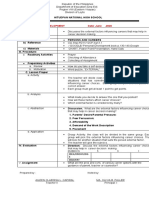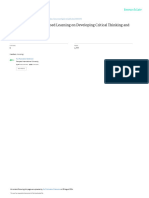0 ratings0% found this document useful (0 votes)
326 viewsPerdev Q2w2
This document discusses adolescent social development and relationships. It covers four main types of relationships that influence adolescents: parents, peers, community, and society. It also discusses how culture shapes adolescent development and can positively or negatively impact beliefs and lifestyles. The document provides examples of civic responsibility and benefits of community involvement, then includes activities for students to assess their understanding.
Uploaded by
l.a. lopezCopyright
© © All Rights Reserved
Available Formats
Download as DOCX, PDF, TXT or read online on Scribd
0 ratings0% found this document useful (0 votes)
326 viewsPerdev Q2w2
This document discusses adolescent social development and relationships. It covers four main types of relationships that influence adolescents: parents, peers, community, and society. It also discusses how culture shapes adolescent development and can positively or negatively impact beliefs and lifestyles. The document provides examples of civic responsibility and benefits of community involvement, then includes activities for students to assess their understanding.
Uploaded by
l.a. lopezCopyright
© © All Rights Reserved
Available Formats
Download as DOCX, PDF, TXT or read online on Scribd
You are on page 1/ 2
Personality Development, Grade 11, 2nd Quarter, 2nd Week
.
LO 10: Social Relationships in Middle and Late Adolescence
10.1 distinguish the various roles of different individuals in society and how they can
influence people through their leadership or followership EsP-PD11/12SR-IIb-10.1
10.2 compare one’s perception of himself/herself and how others see him/her
EsP-PD11/12SR-IIc-10.2
10.3 conduct a mini-survey on Filipino relationships (family, school, and community)
EsP-PD11/12SR-IIc-10.3
HOW CULTURE SHAPES MANY ASPECTS OF ADOLESCENT DEVELOPMENT
Adolescence is a crucial period in social development. There are 4 main types of relationships
that influence an adolescent:
PARENTS
PEERS
COMMUNITY
SOCIETY
COMMUNITY, SOCIETY AND CULTURE
• Culture is learned and socially shared and it affects all aspects of an individual's life
• Many distinguish characteristics of an individual are all products of culture.
Factors that shape adolescent development vary by culture
The lifestyle of an adolescent in a given culture is also profoundly shaped by the roles
and responsibilities he or she is expected to assume.
Differences between families in the distribution of financial responsibilities or provision of
allowance may reflect various socioeconomic backgrounds.
Based on their interaction with social, familial, and cultural environments.
The range of attitudes that a culture embraces on a particular topic affects the beliefs, lifestyles
and perceptions of its adolescent and can have both positive and negative impacts on their
development. Being part in club activities increased youngsters’ happiness levels.
Community activities is part of Civic Responsibility
It’s about doing things in our community because we want to or feel we should, rather
than because we have to by law.
You can take Civic Responsibility and be active in your community by:
Joining a Youth club, scouting group, local environment or clean up
group.
Helping with a primary school or coordinating or coaching junior sport
Setting up an arts space for the community or getting involved in Youth radio
Benefits of being involved in Community Activities
Role Models. Interacting and cooperating with other adults encourages you to see the
world in different ways.
Identify and Connection. Being involved in community activities can give you a positive
way of understanding who you are.
Skills. Community activities give you chance to apply skills you already have.
Self Confidence, mental health and wellbeing Community activities can help boost
one’s self confidence
Activity 10.1: True or False
Directions: Answer the following statements with True or False
1. Culture is learned and socially shared
2. Early Adolescence is a crucial period in social development.
3. Characteristics of an individual are all products of culture.
4. The range of attitudes that a culture embraces on a particular topic does not affects the
beliefs, lifestyles and perceptions
5. The four main types of relationships that influence an adolescent: are parents, peers,
communication and society.
6. Being part in club activities increased youngsters’ happiness levels.
7. Civic Responsibility is about doing things in our community actively but with limitations.
8. Setting up an arts space for the community is one example of Civic Responsibility.
9. Being involved in community activities can give you a positive and negative way of
understanding who you are.
10. Community activities can help boost one’s self confidence
Activity 10.2: My Organizations
Directions: Fill up what is being asked on each column by writing your organization you have
Name of Organization Type of Organization My position/Role
in the Organization
Example of Organization: Neighborhood association, church group, singing/dance group,
community organization, youth group, club, school organization, volunteer group. etc.
Activity 10.3: Brainwriting
Directions: Let us now test what you have learned by answering the questions
that follow.
1. How does your organization develop your social relationship or social
development?
_______________________________________________________________________
_____________________________________________________
2. How does culture affect social relationship of a person?
_______________________________________________________________________
_____________________________________________________
1. Do you have a healthy social relationship, why?
_______________________________________________________________________
_____________________________________________________
Your answer will be evaluated with following points:
5 4 3 2
Presence of Presence of Partially The answer
key words, key words but mentioned the was not
correct usage not observed key words not related to the
of grammar the correct observed given
grammar correct grammar question
Prepared by:
LOTIS A. LOPEZ
Master Teacher I
You might also like
- FAMORCAN, MAVELLE A WEEK 4. - PERSONAL DEVELOPMENT - gRADE 11No ratings yetFAMORCAN, MAVELLE A WEEK 4. - PERSONAL DEVELOPMENT - gRADE 114 pages
- Module 4 The Challenges of Middle and Late AdolescenceNo ratings yetModule 4 The Challenges of Middle and Late Adolescence18 pages
- Unit Iii: Building and Maintaining Relationships Activity 1: Statement On RelationshipsNo ratings yetUnit Iii: Building and Maintaining Relationships Activity 1: Statement On Relationships11 pages
- 4 Social Relationships in Middle and Late Adolescence PerDev Week 4 Module 3 Q2No ratings yet4 Social Relationships in Middle and Late Adolescence PerDev Week 4 Module 3 Q28 pages
- Social Relationship in Middle and Late Adolescence HandoutNo ratings yetSocial Relationship in Middle and Late Adolescence Handout1 page
- Family Structures and Legacies I. Learning CompetenciesNo ratings yetFamily Structures and Legacies I. Learning Competencies10 pages
- 2ntroduction To The Philosophy of The Human Person Quarter 2 - Module 7No ratings yet2ntroduction To The Philosophy of The Human Person Quarter 2 - Module 75 pages
- PerPerDev - Q1 - 3 - Developing The Whole Person Evaluate One - S PersonalityNo ratings yetPerPerDev - Q1 - 3 - Developing The Whole Person Evaluate One - S Personality17 pages
- Perdev - Q2 - Lesson4 - Social Relationship in Middle and Late AdolescenceNo ratings yetPerdev - Q2 - Lesson4 - Social Relationship in Middle and Late Adolescence21 pages
- PerDev - Q2 - Module 1 Personal Relationship EDITEDNo ratings yetPerDev - Q2 - Module 1 Personal Relationship EDITED28 pages
- Discusses The External Factors Influincing Career Choices That May Help in Career Decision MakingNo ratings yetDiscusses The External Factors Influincing Career Choices That May Help in Career Decision Making1 page
- The Challenges of Middle and Late AdolescenceNo ratings yetThe Challenges of Middle and Late Adolescence9 pages
- Personal Relationship: Attraction, Love, and Commitment0% (1)Personal Relationship: Attraction, Love, and Commitment43 pages
- Personality Development Weeks 1-2 ModuleNo ratings yetPersonality Development Weeks 1-2 Module13 pages
- Personal Development: Quarter 2: Module 6No ratings yetPersonal Development: Quarter 2: Module 67 pages
- L Earning Activity Sheet - PERDEV 12: Learning Competency With Code: Discuss That Understanding The IntensityNo ratings yetL Earning Activity Sheet - PERDEV 12: Learning Competency With Code: Discuss That Understanding The Intensity13 pages
- Lesson 8 - Social Relationships in Middle and Late AdolescenceNo ratings yetLesson 8 - Social Relationships in Middle and Late Adolescence41 pages
- Important Component of Setting Career and Life GoalsNo ratings yetImportant Component of Setting Career and Life Goals9 pages
- Shs Perdev Idea-Exemplar Melc24 q2 Minerva-B.-Villan 2020No ratings yetShs Perdev Idea-Exemplar Melc24 q2 Minerva-B.-Villan 202014 pages
- Schools Division of Parañaque City: Personal Development First Quarter, Weeks 1-3No ratings yetSchools Division of Parañaque City: Personal Development First Quarter, Weeks 1-313 pages
- Personal Development: Quarter 1-Module 3 Week 3&4No ratings yetPersonal Development: Quarter 1-Module 3 Week 3&412 pages
- Personal Development Summative Test For Week 6No ratings yetPersonal Development Summative Test For Week 61 page
- Part I. Multiple Choice: "Zero Is Always Better Than Cheaten One Hundred"No ratings yetPart I. Multiple Choice: "Zero Is Always Better Than Cheaten One Hundred"6 pages
- Personal Development: Quarter 4 - Week 8 Insights Into One's Personal DevelopmentNo ratings yetPersonal Development: Quarter 4 - Week 8 Insights Into One's Personal Development15 pages
- Darlene David - 12 - STEM-2 - PERDEV-Module-Quarter-2-Week-6100% (2)Darlene David - 12 - STEM-2 - PERDEV-Module-Quarter-2-Week-64 pages
- Module in Perdev - Emotional IntelligenceNo ratings yetModule in Perdev - Emotional Intelligence9 pages
- Schools Division of Calapan City: Republic of The Philippines Department of EducationNo ratings yetSchools Division of Calapan City: Republic of The Philippines Department of Education2 pages
- Managpi National High School: Produce Organic Concoction Tle - Afoa9-12Co-Iiia-J-Iva-J-1No ratings yetManagpi National High School: Produce Organic Concoction Tle - Afoa9-12Co-Iiia-J-Iva-J-12 pages
- Managpi National High School: Schools Division of Calapan CityNo ratings yetManagpi National High School: Schools Division of Calapan City1 page
- Managpi National High School: Managpi, Calapan City, Oriental Mindoro, 5200No ratings yetManagpi National High School: Managpi, Calapan City, Oriental Mindoro, 52002 pages
- Managpi National High School: Managpi, Calapan City, Oriental Mindoro, 5200No ratings yetManagpi National High School: Managpi, Calapan City, Oriental Mindoro, 52002 pages
- Managpi National High School: Department of Education Mimaropa Region Division of Calapan City100% (5)Managpi National High School: Department of Education Mimaropa Region Division of Calapan City2 pages
- Career Guidance Orientation-Pedro VPMNHSNo ratings yetCareer Guidance Orientation-Pedro VPMNHS3 pages
- Development of Individual Farming SystemNo ratings yetDevelopment of Individual Farming System13 pages
- Argumentative Essay - Extra-Curricular ActivitiesNo ratings yetArgumentative Essay - Extra-Curricular Activities1 page
- Value As A Moderator in Subjective Well-Being: Shigehiro Oishi Ed Diener Eunkook Suh Richard E. LucasNo ratings yetValue As A Moderator in Subjective Well-Being: Shigehiro Oishi Ed Diener Eunkook Suh Richard E. Lucas28 pages
- Effect of E - Learning On Student'S Academic Performance at College LevelNo ratings yetEffect of E - Learning On Student'S Academic Performance at College Level5 pages
- Why Facilitating Progress Is Key To Employee Engagement 1687790031No ratings yetWhy Facilitating Progress Is Key To Employee Engagement 168779003127 pages
- Application Checklist: (Please Tick For Documents Submitted)No ratings yetApplication Checklist: (Please Tick For Documents Submitted)2 pages







































































































